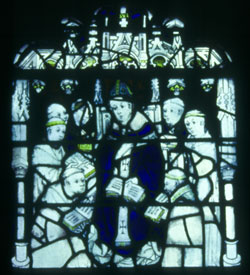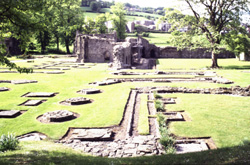 |
 |
 |
 |
 |
 |
 |
|
Fluctuating fortunes: public life (3/3)
The Yorkshire abbots ranked alongside the leading lords in the North and engaged in local litigation and arbitration; from the mid-thirteenth century they also attended parliament. Several abbots played a prominent role in political affairs. In 1138 Richard of Fountains accompanied the papal legate on his tour of the North of England and Scotland; in 1151 Aelred of Rievaulx was sent to negotiate peace between the young prince, Malcolm of Scotland, and the rebel clansmen. In the late twelfth century Abbot Silvanus of Rievaulx helped to heal the rift between the king of Scotland and the abbot of Melrose, and in 1326 the abbot of Rievaulx accompanied several lords to negotiate peace with Robert the Bruce. The most significant impact that the Cistercians had on political affairs was in 1141-7, when their objection to the election of the royal candidate, William Fitzherbert, as archbishop of York, led to his deposition by Eugenius III in 1147, and the consecration of a fellow Cistercian, Henry Murdac. King Stephen refused to invest Murdac who was, significantly, the first diocesan since 1066 to be appointed without royal assent. Whilst the Cistercians had, from their outset, faced famine, floods and the ravages of war, and indeed many of the abbeys were founded during the anarchic years of Stephen’s reign, from the late twelfth century they became more deeply affected by external affairs. They were hit hard financially by Richard I’s ransom which cost them a year’s supply of wool in 1193 and 1198; their refusal to pay John’s taxation for his campaign to Ireland had severe repercussions, for the king in turn imposed an extortionate fine - the Meaux chronicle states that this ruined the house.(4) Crusading tithes and demands for levies to support wars against France and Scotland added to their burdens, but the Northern houses suffered more acutely than others from the Scottish raids. In 1313 the monks of Sawley complained that the raids had devastated their community; their goods had been destroyed, their buildings burnt and they could no longer support themselves, let alone administer hospitality and charity.(5) The situation intensified following the defeat of the English at Bannockburn in 1314, for the North of England now lay open to Scottish invaders: Fountains was occupied by the Scots in 1318 and burnt on several occasions the following year; Rievaulx’s losses were acknowledged by the king in 1331 and Byland’s in 1344.
The Yorkshire monks were also weighed down by
duties relating to the Order. They were saddled with payments to
Cîteaux, and the
abbots were caught up either directly or as arbiters in disputes
with other Cistercian houses. In 1310 the abbots of Roche
and Whalley clashed over
tithes from their possessions in Hillingthorpe, Lancashire. The
case was referred to the
General Chapter, which appointed the abbots of Rievaulx
and Buildwas as arbiters;
it was decided that the abbot of Roche should pay the abbot of Whalley
the annual sum of 40p silver, as well as a pound of wax and a pound
of frankincense for the tithes of all lands cultivated and pertaining
to Hillingthorpe. Disputes could be of a rather more violent nature.
At the beginning of the fourteenth century insurrection broke out
at the abbey of Meaux over the appointment of Abbot Thomas Burton.
When the abbots of Roche and Furness
arrived to investigate the matter they found the gates of the abbey
firmly closed, and were forcibly repelled by men brandishing bows,
arrows and other warlike weapons. |

